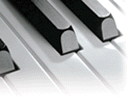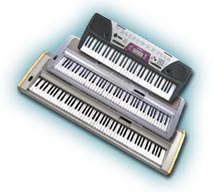|
Portable keyboards
come in different lengths. What matters is the
number of keys and the size of the keys.
Compared to playing a piano, the keys have a
light-weight feel (more like an organ). If you
want a keyboard that feels like a playing a
piano, you'll usually have to look for a
"weighted" key digital piano.
Full-Size Keys
 Full-size keys
are recommended so that the spacing is the same as
that of a standard grand piano.
Mini keys on mini portable keyboards may suit very young children's hands. However, they will get used to the
non-standard size keys and then need to adjust to bigger
keys when playing another keyboard or piano. All the
keyboards at Allegro Music have full-size keys. Full-size keys
are recommended so that the spacing is the same as
that of a standard grand piano.
Mini keys on mini portable keyboards may suit very young children's hands. However, they will get used to the
non-standard size keys and then need to adjust to bigger
keys when playing another keyboard or piano. All the
keyboards at Allegro Music have full-size keys.
 Number
of Keys Number
of Keys
A piano has 88 keys. Portable keyboards can have 49,
61, 76 or 88 keys (mini keyboards can have even fewer).
Students can start with 61 keys, a span of 5 octaves.
You won't use more keys until you progress to complex
pieces at a more advanced level. The keyboards at Allegro Music have 61 or more
keys.
Touch Sensitivity
(or Touch Response)
A
keyboard which features touch sensitivity has the ability
to control the volume of a note according to how hard a
key is struck. Press hard, the note is louder; press softly,
it's quieter. Without touch sensitivity, only the
keyboard's volume setting affects the volume of the
notes played. Although not essential to a beginner,
touch sensitivity can be very helpful. It allows you to hear whether
you're playing evenly and introduces you early to the
concept of expressive playing. Many keyboards have a
button to switch off touch sensitivity, which is useful
for authentic organ or harpsichord playing.
Aftertouch
On many professional
models (including those offered by Yamaha and Roland), the keys respond to aftertouch which is how much pressure you
apply to the key while it's held down. The aftertouch
feature is a convenient way of adding more effects
to the sound, like vibrato.
|
